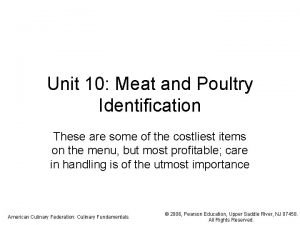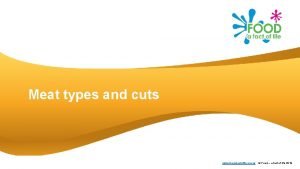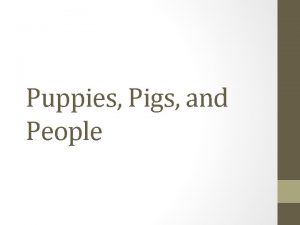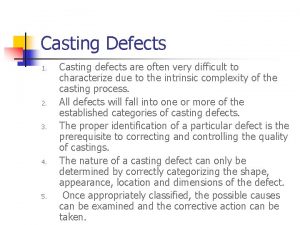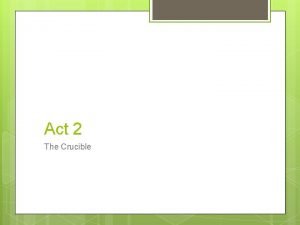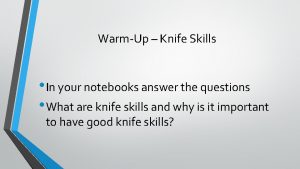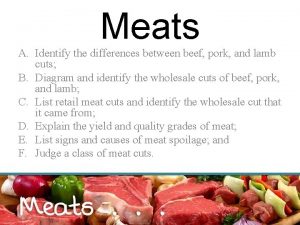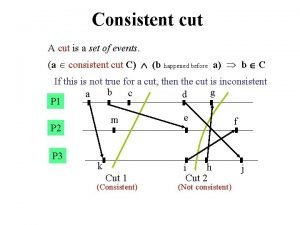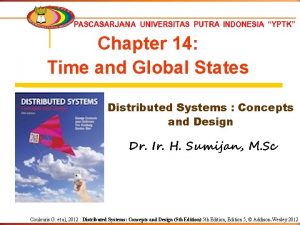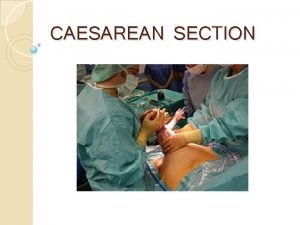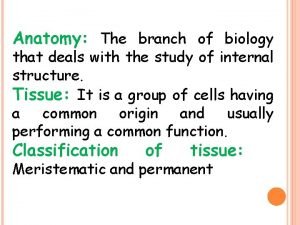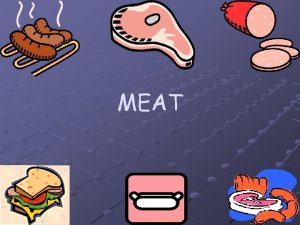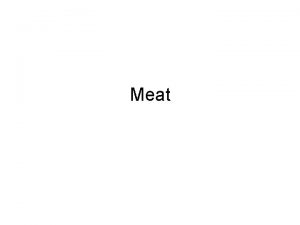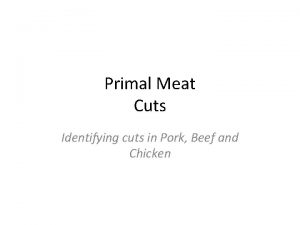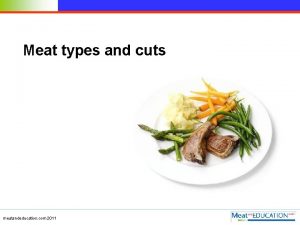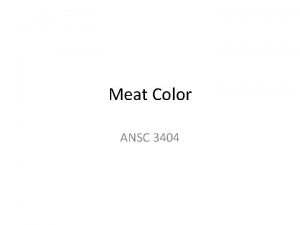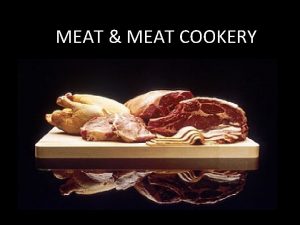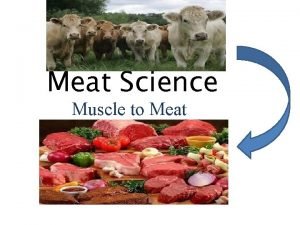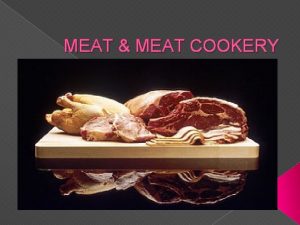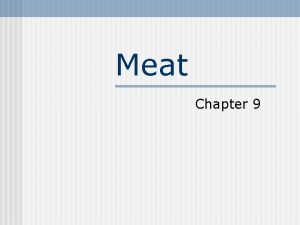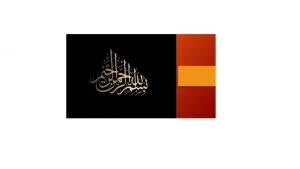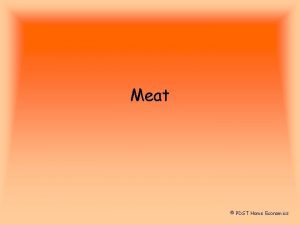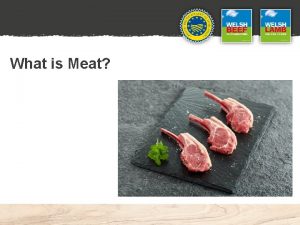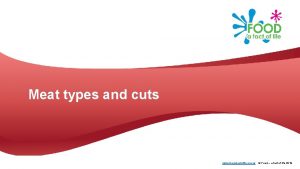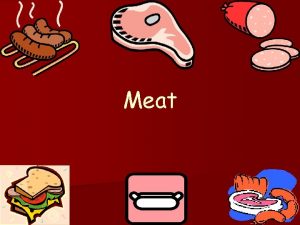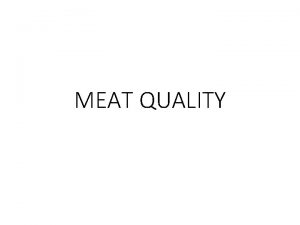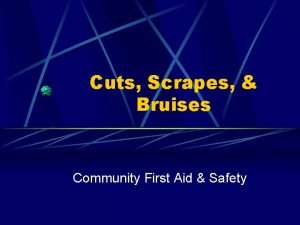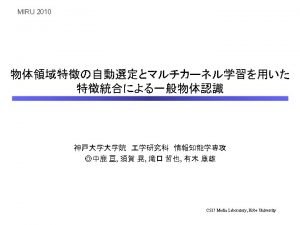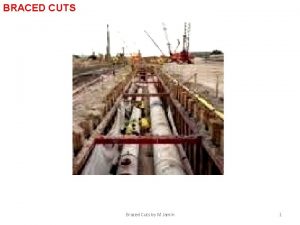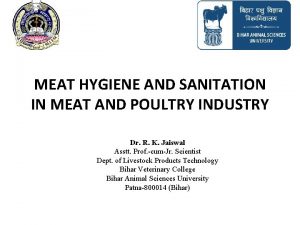Meat Types and Cuts Module Focus Most people


























- Slides: 26

Meat Types and Cuts

Module Focus • Most people buy their meat in the form of cuts, joints or mince. Meat is also bought ready prepared, e. g. sausages, ham, burgers, kebabs. • Knowing where meat comes helps you know how to prepare, cook and serve it. • This module is about the different cuts of beef, pork and lamb which are available

Introduction Cuts of meat are prepared by butchers in shops or supermarkets to meet the different needs of consumers. A wide range of different cuts are available, giving greater choice and variety. Carcase meat is prepared into cuts, joints and mince to make it: • Convenient to buy in smaller amounts; • Convenient to buy in suitable portions sizes, e. g. chops, steaks; • Easier to prepare and quicker to cook; • Easier to store safely. For more learning resources visit www. hcctrade. co. uk

Meat Today the consumer is looking for meat that: • Can be used in different ways; • Is convenient to prepare; • Simple to store; • Easy to cook; • Is low in fat. For more learning resources visit www. hcctrade. co. uk

Where We Buy Meat The way we buy meat is changing. Traditionally consumers would purchase meat from their local butchers. These days butchers make up less than 7% of meat sales, with the top five multiple retailers taking 67%, discounters 19%, convenience stores 6% and internet sales including meat box schemes taking 6% of retail market share for red meat. For more learning resources visit www. hcctrade. co. uk

Meat Today • Boneless cuts (beef, pork and lamb) – economical and suitable for quick and easy methods of cooking, e. g. grilling. • Boned and rolled joints of meat – smaller joints to reduce cooking time and making it easier to carve. • Lean and extra lean cuts – trimmed cuts of meat which are lower in fat. For more learning resources visit www. hcctrade. co. uk

Meat Today • Cubes of meat – sold cut into cubes, ready for making stews, kebabs and casseroles. • Lean minced meat – meat is trimmed of fat and minced. • Thin strips – meat is pre-cut into strips, suitable for quick cooking methods, e. g. stir-frying. For more learning resources visit www. hcctrade. co. uk

Identifying Cuts of Meat A carcase of beef, pork or lamb is divided into different cuts – which may vary according to the carcase weight and quality. Therefore cuts of meat vary in energy and nutrients, composition, weight and fat level. Although there are these variations, retail cuts of meat are influenced by the structure and composition of the carcase, e. g. the position of bones and muscles. For more learning resources visit www. hcctrade. co. uk

Identifying Cuts of Meat In general terms: • The front half (forequarter) of a carcase has more muscles (per cut of meat) which have worked harder, contain more connective tissue and therefore give less tender meat; • Cuts of meat from the neck and shoulder muscles, in particular, have long thick fibres and contain a lot of connective tissue. For more learning resources visit www. hcctrade. co. uk

Identifying Cuts of Meat In general terms: • The back half (hindquarters) of a carcase contains fewer muscles (per cut of meat), which have done less work, have less connective tissue, and therefore produce the most tender cuts of meat. • Cuts of meat from the loin and rump muscles have done the least work and have shorter, finer muscle fibres with less connective tissue and are prime tender cuts. For more learning resources visit www. hcctrade. co. uk

Beef Meat Cuts mp Topside & Silverside Ru t lle Fi Ch Bl uck ad & Fo e re rib Identify which cuts are suitable for slow cooking? Neck Leg Shin For more learning resources visit www. hcctrade. co. uk Brisket Sirloin Top Rump

Lamb Meat Cuts Shoulde r Best End Loin Leg Neck Breas t Chump/ Rump Identify which cuts would have a higher amount of connective tissue For more learning resources visit www. hcctrade. co. uk

Pork Meat Cuts Leg Chump/ Rump Identify which cuts are most likely to be more tender Loin Shoulde r Belly Hock For more learning resources visit www. hcctrade. co. uk

Choice and Variety To add extra choice and variety, pork can be cured and smoked. Bacon is produced by curing pork with salt or in a brine solution. After maturing it is sold as unsmoked bacon. It can also be smoked to give the bacon a darker colour and distinctive flavour. Gammon is the cured whole leg of pork. It is often cut into easy to cook slices and eaten hot as gammon steaks. It is also sold cooked and cold as ham. Some hams may be cured and cooked to a special recipe to give distinctive flavours, such as ‘honey roast’. For more learning resources visit www. hcctrade. co. uk

Choice and Variety Offal is not strictly a meat cut – it is the word used to describe those parts of cattle, pigs and sheep which are cut away (off-falls) from the carcase when it is being prepared for sale. Offal types • Inside the carcase – these include liver, kidney, heart, tongue, sweetbreads and tripe. Blood is also a type of offal, and is used in the making of black pudding. • External part of the carcase – these include pig trotters, ox cheeks and oxtail. For more learning resources visit www. hcctrade. co. uk

Meat Cuts and Cooking The method of cooking selected for a cut of meat will depend on: • The type of muscle fibre it is made up from; • The amount of connective tissue it contains. Cuts of meat which are from muscle areas which do a lot of work will need longer, slower cooking methods, e. g. stew, casserole. Cuts of meat which are from muscles areas not so heavily used by the animal can be cooked much more quickly, e. g. grilling, stir-frying. Offal such as oxtail and heart need longer, slower cooking such as braising or casseroling. Liver and kidney need shorter cooking methods. Liver can also be cooked and minced to make pâté. For more learning resources visit www. hcctrade. co. uk

Cooking Techniques Barbequing Cooking food (normally in an outdoor environment) on a pre-heated trivet or grill, over wood or charcoal embers or gas flame. Frying Shallow: cooking food, in a small amount of fat, in a shallow pan. Stir: quickly cooking food, with or without fat, over a high heat. Deep: cooking food in a large amount of pre-heated fat. Grilling Quickly cooking or browning food under the radiant heat of an electric element or a gas flame. This is only appropriate for tender cuts of meat, no more than 5 cm thick. For more learning resources visit www. hcctrade. co. uk

Cooking Techniques Roasting Cooking food using dry, high temperatures in an oven. The dry heat caramelises the surface of the meat. Casseroling/Braising/ Stewing Slowly cooking tougher cuts of meat, in plenty of liquid with a tight fitting lid. Braised meat sits on a thick bed of vegetables with strong stock. The cut of meat used is normally cubed, diced or steaks. Pot roasting Cooking a joint of meat, which has first been browned, on top of vegetables, with very little liquid, in a pot with a tight fitting lid. For more learning resources visit www. hcctrade. co. uk

Cooking Techniques: Beef Barbequing Frying Grilling Sirloin Steak Rump Steak Ribeye Steak For more learning resources visit www. hcctrade. co. uk

Cooking Techniques: Beef Roasting Casserole/Braising/Stewing Pot Roasting Topside, Silverside, Rib Joint Short Ribs Silverside, Brisket Joint For more learning resources visit www. hcctrade. co. uk

Cooking Techniques: Lamb Barbequing Frying Grilling Boneless Leg Steaks Stir Fry Strips Chops, Loin, Chump, Cutlets For more learning resources visit www. hcctrade. co. uk

Cooking Techniques: Lamb Roasting Casserole/Braising/Stewing Pot Roasting Leg Chops, Cutlets Shoulder For more learning resources visit www. hcctrade. co. uk

Cooking Techniques: Pork Barbequing Loin Steak For more learning resources visit www. hcctrade. co. uk Frying Tenderloin, Fillet Strips Grilling Chops

Cooking Techniques: Pork Roasting Belly For more learning resources visit www. hcctrade. co. uk Casserole/Braising/Stewing Shoulder Pot Roasting Chops

Summary • Meat is available to buy in the form of cuts, joints or mince. It is also available ready prepared, e. g. sausages, ham, burgers. • These types of cuts make it easy for the consumer – they provide choice, and are convenient to prepare, simple to store and easy to cook. • Different cuts of meat have different characteristics, e. g. energy and nutrients, composition, weight, size and appearance. • Because of where the cut of meat comes from on the animal, different cuts require different cooking methods, e. g. slow (casserole), quicker (stir-fry). • To add choice and variety, pork is cured. Offal is also available to be used in a range of popular dishes, e. g. liver and bacon. For more learning resources visit www. hcctrade. co. uk

Meat Types and Cuts For further information and support, go to: www. hybucig. cymru www. eatwelshlambandwelshbeef. com www. porcblasus. cymru www. hcctrade. co. uk For more learning resources visit www. hcctrade. co. uk
 Spaghetti meat market form
Spaghetti meat market form Market forms of meat
Market forms of meat Why is carcase meat prepared into cuts joints and mince
Why is carcase meat prepared into cuts joints and mince Porter's competitive strategies
Porter's competitive strategies Cost leadership strategy
Cost leadership strategy Language
Language Actor focus vs object focus
Actor focus vs object focus Norcross puppies pigs
Norcross puppies pigs Solid
Solid Focus module
Focus module Focus module
Focus module Types of roof ventilation cuts
Types of roof ventilation cuts C device module module 1
C device module module 1 People as media example
People as media example Casting defect
Casting defect People killin people dyin
People killin people dyin 3 external conflicts in the crucible act 2
3 external conflicts in the crucible act 2 People most affected by the issue
People most affected by the issue Basic knife cuts chart
Basic knife cuts chart How to tell the difference between pork and beef
How to tell the difference between pork and beef Consistent cut and inconsistent cut
Consistent cut and inconsistent cut Suicide cuts across all social categories
Suicide cuts across all social categories Cuts of a distributed computation
Cuts of a distributed computation C section cuts through how many layers
C section cuts through how many layers Cell
Cell What is consistent cut
What is consistent cut Dykes meaning in geography
Dykes meaning in geography

